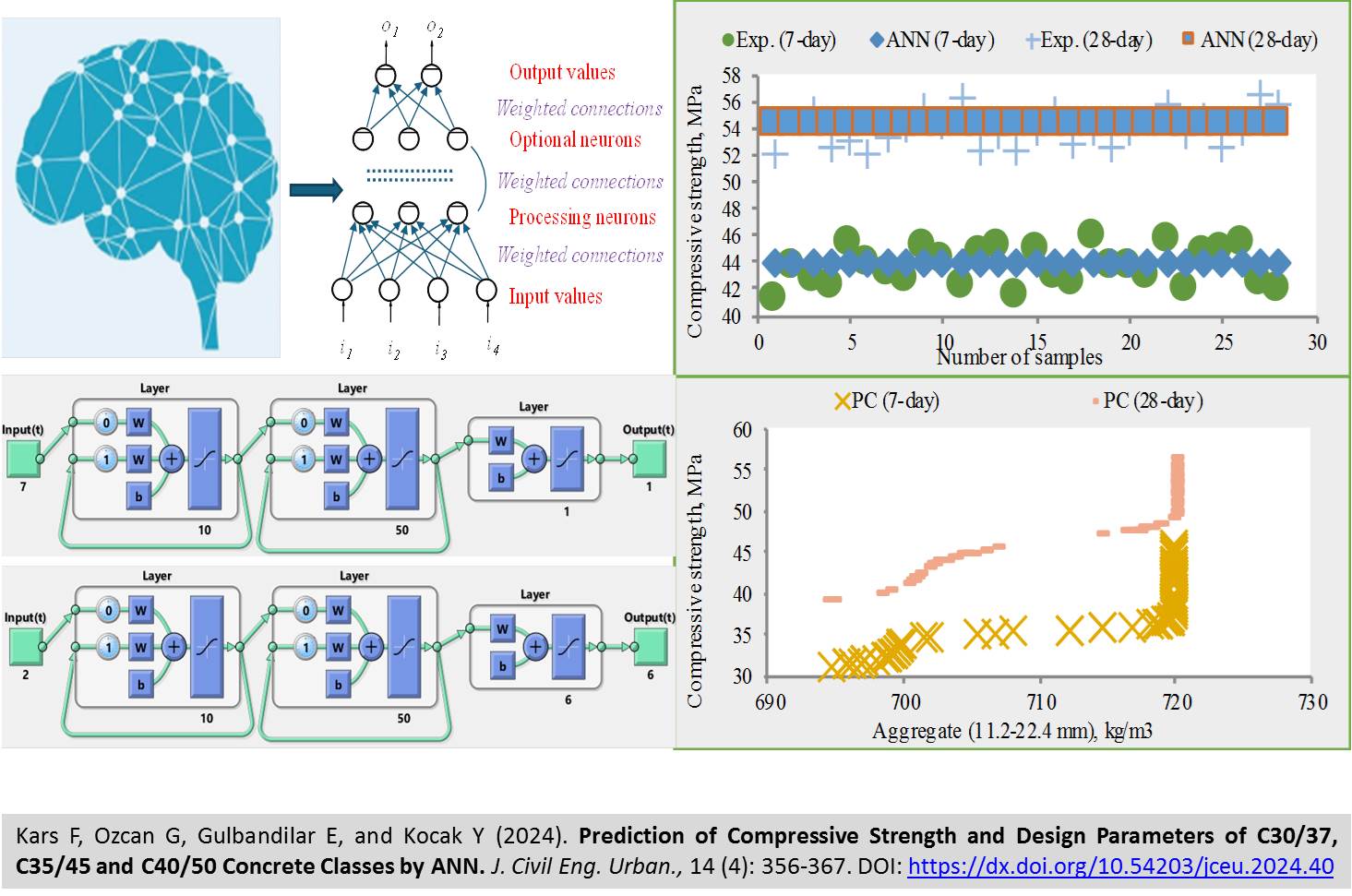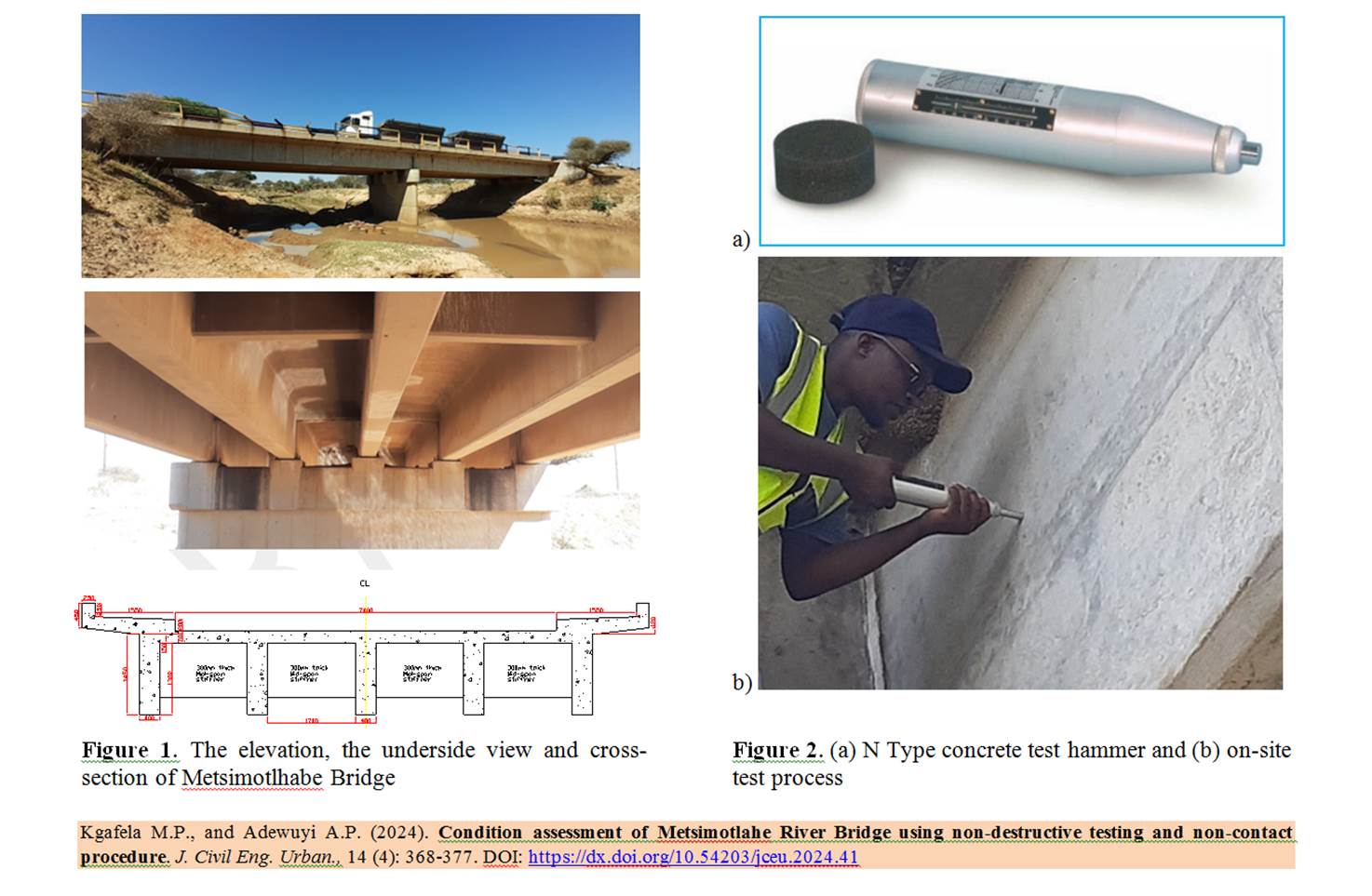Most read content
Partner Journal
<Previous issue | Next issue> | Archive
Volume 14 (4); 25 December, 2024
|
|
Research Paper
Prediction of Compressive Strength and Design Parameters of C30/37, C35/45 and C40/50 Concrete Classes by ANN
Kars F, Ozcan G, Gulbandilar E, and Kocak Y.
J. Civil Eng. Urban., 14(4): 356-367, 2024; pii:S225204302400040-14
 DOI: https://dx.doi.org/10.54203/jceu.2024.40
DOI: https://dx.doi.org/10.54203/jceu.2024.40
Abstract
The quality of concrete used in the construction sector is increasing day by day with ready-mixed concrete production. The quality of concrete is directly related to its compressive strength and the related tests are labor-intensive and time-consuming. Therefore, different artificial intelligence-based models are used to predict the compressive strength of concrete. In this study, compressive strength and design parameters of concrete classes C30/37, C35/45 and C40/50 were predicted by ANN model. A total of 240 compressive strength results obtained from concretes produced in a ready-mixed concrete plant for the construction of columns, beams, decks and stairs. 70% of these data were used for training and remaining 30% of data were reserved for testing. The prediction accuracy of the ANN model was evaluated by R2, MAPE and RMSE statistical methods. According to results, the compressive strengths of concrete classes C30/37, C35/45 and C40/50 could be predicted with errors of -0.70%, 1.25% and 0.17% for 7 days and 0.99%, 0.03% and -0.69% for 28 days, respectively. Depending on the design parameters, it was found that prediction performance could be made with almost 100% accuracy for all concretes except high-performance superplasticizer admixture. As a result, it was concluded that ‘very good’ or ‘high accuracy’ predictions can be made with ANN models.
Keywords: ANN, Compressive Strength, Concrete, Design Parameters.
[Full text-PDF] [Crossref Metadata] [Export from ePrints]
|
|
Research Paper
Condition Assessment of Metsimotlhabe River Bridge using Non-Destructive Testing and Non-Contact Procedure
Kgafela M.P., and Adewuyi A.P.
J. Civil Eng. Urban., 14(4): 368-377, 2024; pii:S225204302400041-14
 DOI: https://dx.doi.org/10.54203/jceu.2024.41
DOI: https://dx.doi.org/10.54203/jceu.2024.41
Abstract
A process of in-service infrastructure health assessment using non-destructive testing and evaluation (NDT&E) techniques is crucial for prompt, accurate and quantitative identification of damage in civil infrastructure. The aim of this study was to assess the structural performance of Metsimotlhabe River Bridge through NDT&E and load testing techniques. Schmidt rebound hammer was utilized to determine the compressive strength of the bridge, total station was used to monitor the profile of the bridge girder level for differential deformation, and a non-contact global positioning system (GPS) technology was employed to measure the dynamic displacement of the bridge under random operational traffic loading conditions. Finally, the dynamic behavior of the bridge was evaluated based on displacement, strain and acceleration response data. There was a perfect linear correlation between rebound number and compressive strength of concrete from different contact surfaces. The compressive strength of the bridge superstructure from random sampling was 39.48 N/mm2 (CoV = 19.22%). The normal distribution of the bridge levels at the northern and southern levels depicted differential displacement that indicated torsional deformation. The displacement of the bridge girder was simultaneously monitored at the supports, quarter-spans and mid-span using GPS technology. The results showed functional elastomeric bearings at the supports, perfect correlation at the quarter spans and maximum dynamic flexural displacement of 21.5 mm at the mid-span. The modal decomposition acceleration and displacement response data produced the first three flexural modal frequencies of 6.44 Hz, 9.10 Hz and 19.56 Hz. It can be concluded that while the bridge was in good condition in terms of its compressive strength, elastomeric bearings and fibre strain, the differential displacement at the northern-southern edges of the bridge was a clear indication of torsional deformation of the superstructure.
Keywords: Bridge monitoring, non-destructive testing, compressive strength, rebound hammer, global positioning system (GPS), total station, displacement response, torsional deformation
[Full text-PDF] [Crossref Metadata] [Export from ePrints]
<Previous issue | Next issue> | Archive
This work is licensed under a Creative Commons Attribution 4.0 International License (CC BY 4.0)![]()



